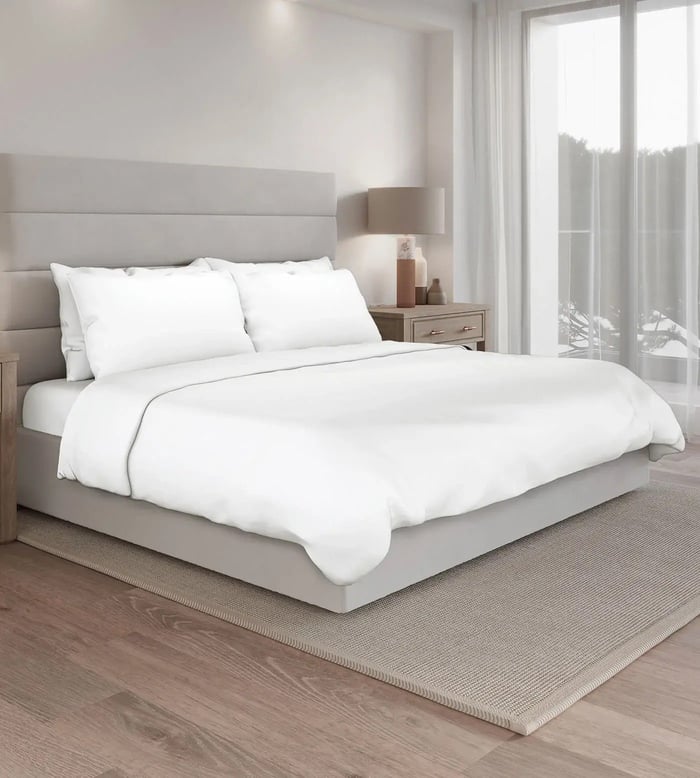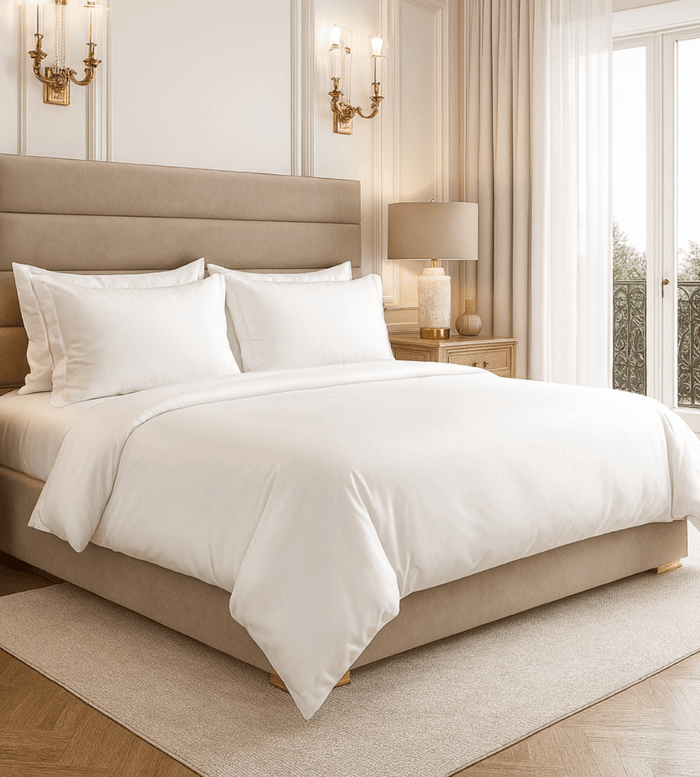Table of Contents
- The Hidden Problem: Why Your Bed is an Allergen Hotspot
- Debunking the Myth: The Truth About Synthetic Hypoallergenic Fills
- The Gold Standard: Understanding Naturally Hypoallergenic Fabrics
- The Superior Solution: Why Bamboo Excels for Sensitive Sleepers
- Lost Loom’s Commitment to Purity and Comfort
- Your Action Plan: Creating an Allergy-Free Sleep Sanctuary
Waking up with itchy eyes, a blocked nose, or unexplained skin irritation is a miserable way to start the day. For millions of people, the culprit isn't the air outside, but the very place they seek comfort: their own bed. It’s a common misconception that hypoallergenic bedding is simply anything made from cheap synthetic fibres. In reality, the world of allergy-friendly bedding is nuanced, luxurious, and rooted in the extraordinary properties of certain natural materials.
If you’re one of the many who struggle with night-time sniffles or sensitive skin, this guide is your definitive resource. We will explore the common allergens lurking in your mattress, debunk the myth that synthetic is always best, and introduce you to the ultimate solution for a pure, comfortable, and truly restful sleep sanctuary.
The Hidden Problem: Why Your Bed is an Allergen Hotspot

We spend roughly a third of our lives in bed, and while we sleep, our bodies shed skin cells, perspire, and create the perfect microclimate for uninvited guests. The most common allergens found in bedding are:
Dust Mites: These microscopic creatures feed on shed skin cells and thrive in the warm, humid environment of a mattress, duvet, and pillow. Their faeces are the primary allergen, triggering asthma and rhinitis.
Mould and Mildew: If bedding traps moisture (from sweat or humidity), it creates a breeding ground for mould spores, which are powerful respiratory irritants.
Chemical Residues: Bedding treated with chemical dyes, harsh bleaches, or fire-retardants can cause contact dermatitis or trigger sensitivities in the form of a persistent, itchy rash.
For years, the standard advice was to opt for synthetic polyester fills, as these materials are easy to wash and less likely to contain organic material that dust mites find appealing. However, modern research and a desire for genuine comfort has proven that the best solutions come from materials that actively work with your body's physiology, such as hypoallergenic options like bamboo.
Debunking the Myth: The Truth About Synthetic Hypoallergenic Fills
When you see "hypoallergenic" on a label, it traditionally means the product is less likely to cause an allergic reaction. For many synthetic duvets and pillows (made from microfibre or hollowfibre), this is achieved because the plastic fibres are inherently inorganic.
However, synthetic fills come with significant drawbacks for the sensitive sleeper:
Poor Temperature Control: Polyester does not breathe well. It traps heat and moisture, leading to excessive sweating. This sweat raises the humidity within the bedding, ironically creating the warm, damp conditions where dust mites and mould thrive.
Lack of Softness: While affordable, synthetic sheets and pillowcases lack the natural, gentle drape of high-quality natural fibres, which can feel rough or clammy against irritated skin.
Chemical Additives: Some synthetic fabrics are still treated with chemical finishes to achieve a softer feel or brighter colour, negating the "purity" you are seeking.
The Gold Standard: Understanding Naturally Hypoallergenic Fabrics
The most effective, comfortable, and luxurious approach to controlling allergens is to choose bedding that has natural hypoallergenic properties. This means the material inherently resists the growth of the irritants you are trying to avoid.
Fabric Material | Key Hypoallergenic Advantage | Comfort Factor |
Silk | Naturally antimicrobial and resistant to dust mites. | Incredibly smooth and luxurious. |
Wool | Excellent at wicking away moisture; dust mites hate its dry environment. | Highly breathable but can feel heavy; requires careful washing. |
Tencel/Lyocell | Made via a clean, closed-loop process; highly breathable and soft. | Excellent moisture management; soft and drapes well. |
Bamboo Viscose | Naturally antimicrobial, highly breathable, and supremely smooth. | Silky soft, extremely cooling, and gentle on sensitive skin. |
While these natural options are superior to synthetics, bamboo stands out among hypoallergenic bedding for combining the best attributes of luxury and performance.
The Superior Solution: Why Bamboo Excels for Sensitive Sleepers
Bamboo bedding, specifically the premium viscose derived from bamboo (like that used by Lost Loom), offers a unique trifecta of benefits that make it the ultimate choice for allergy sufferers and those with skin sensitivities:
Moisture Management: Bamboo is highly breathable and excels at wicking moisture away from the body. Since dust mites and mould require a humid environment, bamboo's ability to keep the sleeping space dry is its most effective defence against these allergens.
Silky Softness: For conditions like eczema or chronic irritation, reducing friction is paramount. Bamboo fibres are naturally smooth and round, giving the fabric a superior, silky texture that glides gently over the skin, unlike the microscopic roughness found in traditional cotton.
Natural Purity: Our commitment to a healthier sleep environment means our bedding is free from the harsh chemicals that can trigger contact allergies. Every piece of Lost Loom bedding is certified by STANDARD 100 by OEKO-TEX®, guaranteeing that the product is completely free from harmful substances, dyes, and chemical residues—a critical benchmark for those seeking truly non-toxic bedding.
Lost Loom’s Commitment to Purity and Comfort

At Lost Loom, we believe you should never have to choose between exceptional comfort and health. Our 100% premium viscose from bamboo collection is meticulously designed to create the purest sleep sanctuary.
Purity in Every Thread: Unlike some bamboo blends that compromise with cotton or synthetics, our Luxury Bamboo Bedding Set is crafted from 100% pure bamboo fibres. This ensures you receive the full benefits of bamboo's natural hypoallergenic and thermoregulating qualities.
Duvet Filling Designed for Health: Our Luxury Bamboo Duvet is a conscious choice for a healthier sleep space. The outer fabric is 100% bamboo, and the filling (50% bamboo, 50% recycled PET for loft) promotes a clean, fresh feel. The hypoallergenic properties of the bamboo fibres actively resist dust mites and other common allergens. Furthermore, the perfect balance of breathability and warmth prevents the overheating that often triggers night-time irritation.
Friction-Free Comfort: Our 400 thread count sateen weave bamboo bedding is smooth and gentle, helping to reduce the friction that can exacerbate sensitive skin and conditions.
Your Action Plan: Creating an Allergy-Free Sleep Sanctuary
Switching your bedding is just the beginning. Follow this simple plan to ensure your bedroom remains a healthy, restorative space:
Encase Your Mattress and Pillows: Use high-quality, tightly woven barrier covers on your mattress and pillows to prevent any existing dust mites from migrating into your new bedding.
Clean Duvets and Pillows Quarterly: Wash your duvet and pillows every three to six months. For items like our Luxury Bamboo Duvet, follow the gentle wash instructions to maintain its loft and hypoallergenic structure.
Reduce Bedroom Humidity: Maintain a low humidity level (ideally below 50%) using a dehumidifier or by ensuring adequate ventilation. This is the single biggest step you can take to make the environment hostile to mould and dust mites. For more detailed advice on managing bedroom temperature, see our blog on [Does Bamboo Bedding Keep You Cool?].
Remove Soft Furnishings: Minimise dust traps by removing heavy curtains, carpets, and excessive decorative pillows that are difficult to wash regularly.
By choosing pure, certified hypoallergenic bedding like the bamboo collection from Lost Loom, you are making an intelligent investment in your comfort, your skin health, and your overall quality of sleep.
Discover the difference that purity makes. Explore the full range of Lost Loom's OEKO-TEX® certified bamboo bedding and start building your ultimate hypoallergenic bedding and sleep sanctuary today.





